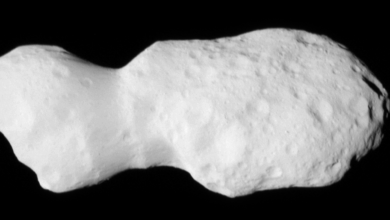5 dazzling interstellar images to celebrate Hubble’s 35th birthday
The Hubble Space Telescope, a joint project between NASA and the European Space Agency (ESA), is celebrating its 35th anniversary this week. Launched on April 24, 1990, aboard the Space Shuttle Discovery (STS-31), the telescope has been instrumental in revolutionizing our understanding of the universe.
Over its three decades of service, the Hubble Space Telescope has made over 1.6 million observations, traveled 13.4 billion light-years, and has been the subject of approximately 21,000 peer-reviewed scientific papers. Some of its most notable achievements include capturing the first space-based images of an asteroid breaking apart and confirming that the Andromeda Galaxy will collide with our Milky Way Galaxy.
To commemorate this milestone, here are five recent images captured by the Hubble Space Telescope:
1. Cosmic Pillar in Eagle Nebula:
The telescope captured a stunning image of a towering structure of billowing gas in the Eagle Nebula (Messier 16). The pillar rises 9.5 light-years tall and is located 7,000 light-years away from Earth. This new image showcases the star factory in a new light using updated image processing techniques.
2. Squid in the Whale:
The Hubble Space Telescope observed the spiral galaxy Messier 77, also known as the Squid Galaxy, located 45 million light-years away in the constellation Cetus (The Whale). The updated image incorporates recent observations and filtering techniques to provide a detailed view of this unique galaxy.
3. Stellar Star Sculptors:
The telescope captured an image of NGC 346, a young star cluster in the Small Magellanic Cloud. This image showcases the cluster within a nebula, with bright blue stars illuminating the surrounding gas clouds.
These recent images are just a glimpse of the incredible work that the Hubble Space Telescope has done over the past 35 years. As we continue to explore the cosmos, the telescope remains a vital tool in our quest to unravel the mysteries of the universe. The Small Magellanic Cloud is a satellite galaxy of the Milky Way, located 200,000 light-years away in the constellation Tucana. This unique galaxy has caught the attention of astronomers and space enthusiasts alike due to its fascinating features and celestial wonders.
One of the most captivating sights in the Small Magellanic Cloud is a young star cluster known as NGC 346. This “star-forming factory” is home to over 2,500 newborn stars, some of which are larger than our sun and emit a brilliant blue light. The remnants of these stellar births can be seen in the sparkling pink nebula and dark clouds that adorn the cluster.
Despite being a satellite galaxy of the Milky Way, the Small Magellanic Cloud differs significantly from its larger counterpart. It contains fewer elements heavier than helium, giving it conditions more akin to the early universe. This makes it a valuable target for studying the evolution of galaxies and the processes that drive star formation.
Moving on to another cosmic marvel, we have the Arp 105 merger, where elliptical galaxy NGC 3561B and spiral galaxy NGC 3561A are in the process of merging. This ongoing cosmic dance is characterized by a long tidal tail of stars and gas stretching over 362,000 light-years, earning it the nickname “The Guitar.” The dark dust lane originating from NGC 3561B feeds a bright blue star-forming region known as Ambartsumian’s Knot, which is a tidal dwarf galaxy formed from the debris of interacting galaxies.
Finally, we have the iconic Sombrero Galaxy, located approximately 30 million light-years away in the constellation Virgo. With its softly luminous bulge and sharply outlined disc, the Sombrero Galaxy resembles the shape of a sombrero, hence its name. While it is not a major hub of star formation, the galaxy is home to a supermassive black hole that is over 2,000 times larger than the one at the center of the Milky Way.
In conclusion, the Small Magellanic Cloud and its cosmic companions offer a glimpse into the diverse and captivating world of galaxies. From vibrant star clusters to mesmerizing cosmic mergers, these celestial wonders continue to inspire and intrigue astronomers and space enthusiasts around the world. The world of technology is constantly evolving, with new innovations and advancements being made on a daily basis. From the latest smartphones to cutting-edge artificial intelligence, there is no shortage of exciting developments in the tech industry.
One of the most recent and exciting advancements in technology is the rise of 5G networks. 5G, short for fifth generation, is the latest iteration of mobile network technology, promising faster speeds, lower latency, and improved connectivity. With 5G, users can expect to download files in a matter of seconds, stream HD content with ease, and experience lag-free online gaming.
But what exactly makes 5G different from its predecessors? One of the key differences is the use of higher frequency radio waves, which allows for more data to be transmitted at faster speeds. This means that 5G networks are capable of handling more devices at once, making them ideal for the growing number of smart devices in our homes and workplaces.
Another important aspect of 5G technology is its low latency, or the time it takes for data to travel from one point to another. With 5G, latency is significantly reduced, making activities like video calling and online gaming much smoother and more responsive.
In addition to faster speeds and lower latency, 5G networks also promise improved connectivity in rural and remote areas. With the ability to transmit data over longer distances, 5G has the potential to bring high-speed internet to areas that were previously underserved.
But with all of these benefits, there are also concerns about the potential health risks of 5G technology. Some studies have suggested that exposure to radiofrequency radiation from 5G networks could have adverse effects on human health, although the scientific consensus is still inconclusive.
Despite these concerns, the rollout of 5G networks is already well underway in many parts of the world. Major telecom companies are investing billions of dollars in infrastructure to bring 5G to consumers, and smartphone manufacturers are releasing 5G-enabled devices to take advantage of the new technology.
As 5G technology continues to develop and expand, it has the potential to revolutionize the way we communicate, work, and interact with the world around us. With faster speeds, lower latency, and improved connectivity, 5G networks are poised to usher in a new era of innovation and opportunity in the tech industry. The world of technology is ever-evolving, with new advancements and innovations being introduced at a rapid pace. One such innovation that has gained immense popularity in recent years is artificial intelligence (AI). AI refers to the simulation of human intelligence in machines that are programmed to think and act like humans. This technology has the potential to revolutionize various industries and improve our daily lives in numerous ways.
One of the key areas where AI is making a significant impact is in healthcare. AI-powered applications and tools are being used to analyze large volumes of medical data and assist healthcare professionals in diagnosing and treating patients. These tools can help in the early detection of diseases, provide personalized treatment plans, and improve overall patient care. For example, AI algorithms can analyze medical images such as X-rays and MRIs to identify abnormalities that may be missed by human radiologists.
In addition to healthcare, AI is also being used in the field of finance to detect fraud, predict market trends, and automate routine tasks. Banks and financial institutions are increasingly adopting AI-powered systems to improve efficiency, reduce costs, and enhance security. AI can analyze vast amounts of financial data in real-time to detect anomalies and potential risks, helping to prevent fraudulent activities and protect customers’ assets.
Another industry that is benefitting from AI technology is transportation. Self-driving cars, powered by AI algorithms, are being developed by companies such as Tesla and Google. These autonomous vehicles have the potential to reduce accidents, improve traffic flow, and provide more efficient and convenient transportation options. AI is also being used in logistics and supply chain management to optimize routes, track shipments, and improve delivery times.
In the field of education, AI is being used to personalize learning experiences for students. Adaptive learning platforms powered by AI algorithms can assess students’ strengths and weaknesses and tailor lesson plans to meet their individual needs. This can help students learn at their own pace and achieve better academic outcomes.
Overall, AI has the potential to transform various industries and improve our daily lives in significant ways. However, it is important to consider the ethical implications of AI and ensure that these technologies are developed and used responsibly. As AI continues to advance, it is crucial for policymakers, industry leaders, and researchers to work together to harness the full potential of AI while addressing any potential risks or challenges that may arise.





